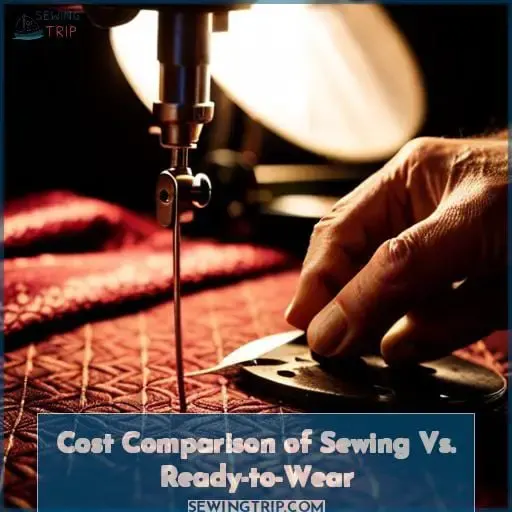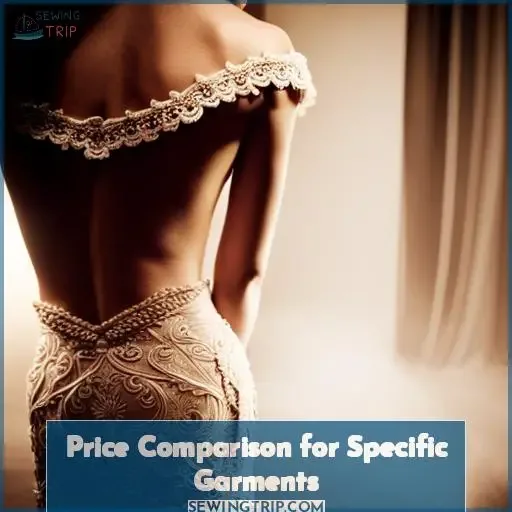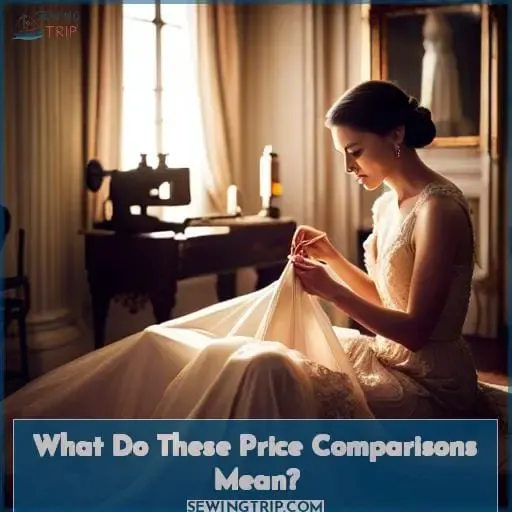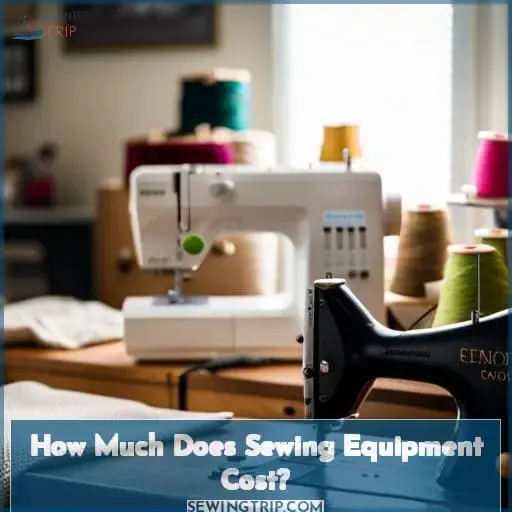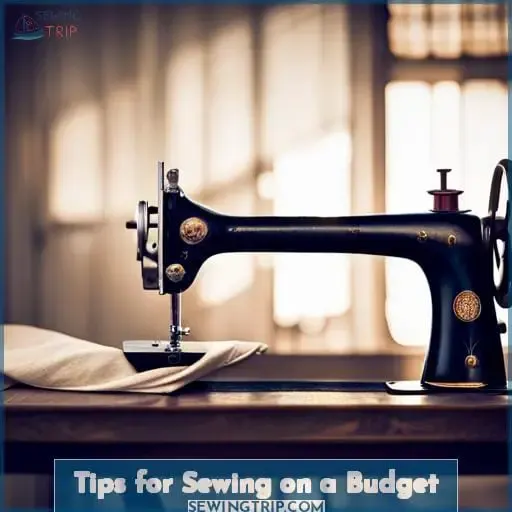This site is supported by our readers. We may earn a commission, at no cost to you, if you purchase through links.
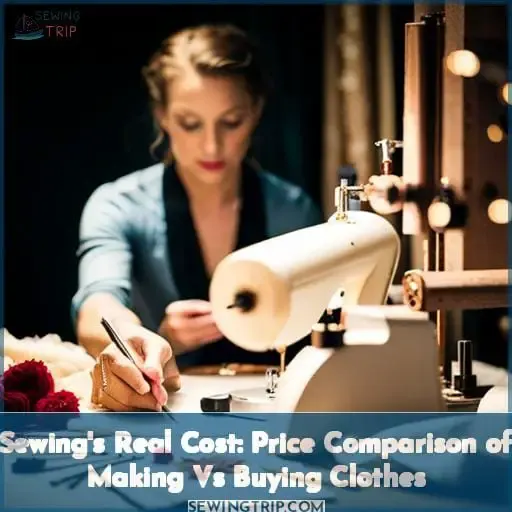 When you compare the price of sewing clothes to buying them, you’ll find that sewing is often cheaper.
When you compare the price of sewing clothes to buying them, you’ll find that sewing is often cheaper.
This is especially true if you sew simple garments, like t-shirts and skirts.
Even if you sew more complex garments, like dresses and jackets, you can still save money by sewing them yourself.
So, if you’re looking for a way to save money on clothes, sewing is a great option.
Table Of Contents
Key Takeaways
- Sewing clothes yourself can save money compared to buying mass-produced options, but it takes more time and skill, especially for complex garments.
- Specific cost comparisons show homemade garments ranging from $50 for leggings to over $200 for jackets, generally cheaper than designer brands but more expensive than low-cost retailers.
- Basic sewing machines suitable for simple projects start under $400; more advanced models with specialized features can cost over $1000.
- Setting a budget, finding deals on supplies, and repurposing materials can help keep sewing costs low.
Cost Comparison of Sewing Vs. Ready-to-Wear
When deciding whether to sew or buy ready-made, carefully compare all costs.
Focus beyond fabric prices to tools, patterns, time, and effort – these quickly add up.
Analyze sample garments like jeans, shirts, and jackets to reveal sewing’s full price tag.
Jeans
Your total cost for sewing jeans lands between $148-$159.25, while mass market jeans range from $34.
Fabric Choices
Custom Embellishments
Fit Adjustments
Sustainability Impact
Time Investment
Shirts
You’ll also see noticeable price differences with button-up shirts.
Cotton shirts made from scratch can cost $98.37–$104 versus $20 at Target or $75 from Everlane.
The flexibility to choose your own fabric and add custom embellishments comes with a higher price tag, but allows you to adjust the fit and style to suit your needs.
This investment of time and money also enables more sustainable clothing practices overall.
| Item | Sewing | Everlane | Indie Brand | Target |
|---|---|---|---|---|
| Cotton Shirt | $98.37-$104 | $75 | $160 | $20 |
| Silk Shirt | $124.50-$137 | $128 | N/A | N/A |
Jackets
Often, jackets made from scratch cost around $205.58-$215.50, while an Everlane jacket runs about $175, an indie label charges around $195, and a Target jacket is just $50.
With sewing, you can customize the style and fabric to suit your tastes.
Independent labels may use higher quality, ethically-sourced materials despite the increased price tag.
Overall, sewing allows creative expression, yet ready-to-wear is frequently cheaper when accounting for time and labor.
Price Comparison for Specific Garments
When it comes to items like leggings, jumpsuits, and dresses, the cost comparison starts getting more interesting.
While ready-to-wear versions can be found very cheaply, making these items yourself opens up much more customization in terms of fabric, fit, and styling.
However, the time and effort involved in sewing must also be factored against the convenience of purchasing inexpensive ready-to-wear versions.
Leggings
You’d spend about $53.50-$58.50 sewing a pair of leggings, while mass retailers offer cheaper options.
However, sewing allows customizing fit, fabric choices, and designs for comfort and ethical production.
Despite potential extra costs, sewing leggings enables personal expression through custom sizing and fabrics.
Jumpsuits
One pays $105.50-$122 to sew a jumpsuit, while ready-to-wear prices range from $29.
Fabric Choices
Customization Options
Time Investment
Eco-Friendly Practices
Whether for creative freedom or an ethical wardrobe, handmaking jumpsuits allows personalization.
Compare indie quality or fast fashion savings against sewing’s joys.
Dresses
The cost of a dress is another useful comparison.
You’ll see home sewing a dress typically runs $80-$90.50, while an Everlane dress is $100 (or $50 on sale), an indie brand charges around $190, and a Target dress costs $29n99.
| Home Sewn | Everlane | Indie Brand | Target |
|---|---|---|---|
| $80-90.50 | $100 ($50 on sale) | $190 | $29.99 |
With clever fabric choices, pattern selection, and alterations, a custom dress offers endless styling options.
Careful planning saves time.
What Do These Price Comparisons Mean?
These numbers show that sewing your own clothes can save money compared to ready-to-wear, but often only if you’re thrifty with fabric and don’t count your time and labor.
Large companies benefit from economy of scale when producing en masse, but may cut costs on labor and fabric quality that impact the environment and workers.
Indie labels charge more due to small batches and ethical business practices, though remain inaccessible to most.
Ready-to-wear is often cheaper simply considering time and monetary investment.
However, sewing allows for customization to match personal style, values, and creative expression.
The time invested in sewing sustains local economies and reduces waste through repairing, altering, and upcycling items.
Choosing sustainable fabrics also minimizes environmental impact.
Ultimately, sewing empowers personal style and choices while building community, though its real value transcends any price tag.
How Much Does Sewing Equipment Cost?
When getting started with sewing, the initial investment in equipment can seem daunting.
However, basic sewing machines suitable for simple projects can be purchased new for under $400.
As your skills progress, you may consider upgrading to more advanced models or adding specialty machines like sergers.
Sewing Machines
When you’re deciding how much to spend on a sewing machine, first assess your skills and project plans to determine what features you require.
Consider three key factors:
- Entry-level machines under $400 suit simple projects with basic stitches and functions.
- Mid-range models from $400-$1000 offer more stitch options, feet, and conveniences for intermediate sewers.
- High-end machines above $1000 provide specialized features like large throat spaces to manage thick fabrics for advanced sewing.
Research online reviews and local dealer options to find the best match for your budget and sewing plans.
Compatibility with your preferred fabrics is also key.
Sergers
One can expect to spend $150 to $400 on a good home serger, depending on the features you’re looking for.
As you advance in sewing, a serger lets you achieve professional seam finishes with versatile stitch options for stretch fabrics.
Compare models based on:
- The number of threads
- Stitch varieties like overlock and rolled hem
- Ease of changing settings
Quality entry-level sergers have 2-3 threads and basic stitches to prevent fraying.
More advanced options offer:
- 4+ threads
- Coverstitch
- Fine-tuning abilities for specialized seams and hem finishes
Focus on functionality fitting your projects’ needs rather than abundant features exceeding your skills.
Tips for Sewing on a Budget
With a bit of thriftiness and clever planning, you can keep your sewing costs low:
- Set a monthly budget.
- Check sales.
- Reuse materials.
- Find free patterns and tutorials.
Shop end-of-season fabric sales and discount shops for designer remnants at huge markdowns.
Check secondhand stores and websites for pre-loved tools, machines, patterns, and fabrics.
Before buying pricey specialty tools, see if regular household items like clothespins or empty thread spools can substitute.
Repurposing old textiles prevents waste and offers materials at zero cost.
Online video lessons, free generator patterns, and digital creators provide high-quality learning tools and design templates economically.
Connecting with other sewing enthusiasts builds community while sharing ideas and skills.
With some resourcefulness, sewing engages creativity and self-expression on a budget.
With clever tips and enthusiasm for discovery, lack of funds need not limit your sewing dreams.
Frequently Asked Questions (FAQs)
How long does it take to make my own clothes vs buying them?
Making your own clothes takes significantly longer than buying ready-made.
You’ll spend hours:
- Sourcing fabric and patterns
- Cutting
- Sewing
- Finishing
Even experienced sewers estimate 10-20 hours for a dress.
Ultimately, you trade money for time, creativity, and customization.
The choice depends on:
- Your budget
- Your skills
- Your personal style preferences
Can I realistically sew all my own clothes or just some key staple items?
With practice, you can absolutely sew some staple wardrobe items yourself.
Focus first on simpler garments like t-shirts, leggings, or underwear to hone skills before tackling more complex pieces.
Ultimately, a mix of store-bought and homemade allows customization without the burden of sewing everything yourself.
What are some good beginner sewing projects to start with?
Start simple—tote bags or pillow covers let you practice seams and zippers without much fabric waste.
Once you’ve mastered straight lines, move on to pajama pants or basic tops to apply those skills on wearable projects.
Check blogs and YouTube for free beginner patterns.
Where can I find sewing patterns and how do I use them?
Check craft stores, online retailers, thrift shops, or your local library for sewing patterns.
Carefully read the pattern instructions and suggested fabrics before starting.
Take accurate measurements of yourself or whoever will wear the finished garment to select the right pattern size.
Start with simple patterns like pajama pants or basic tops to build skills before attempting more complex designs.
Carefully cut out pattern pieces and mark notches and dots before laying out fabric and cutting.
What sewing skills should I learn first as a beginner?
Practice hand-sewing techniques like running stitch and backstitch.
Learn to thread and operate a sewing machine.
Start with easy projects like pillowcases or tote bags.
Focus on mastering skills like cutting fabric, pinning, and pressing as you go.
The goal is simply enjoying the creative process as a beginner.
Conclusion
After reviewing costs, it’s clear that with some investment up front, sewing your own clothes should yield significant long-term savings.
Like planting seeds, your initial purchases of fabric, patterns, and tools will blossom into a sustainable and affordable wardrobe.
So take the plunge into sewing your own stylish, custom-fitted clothes at a fraction of ready-to-wear prices. You’ll quickly recoup costs while expressing personal creativity for years to come.

